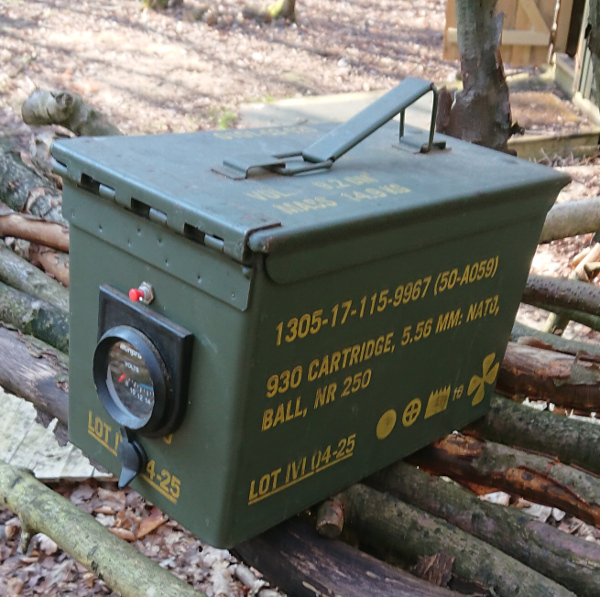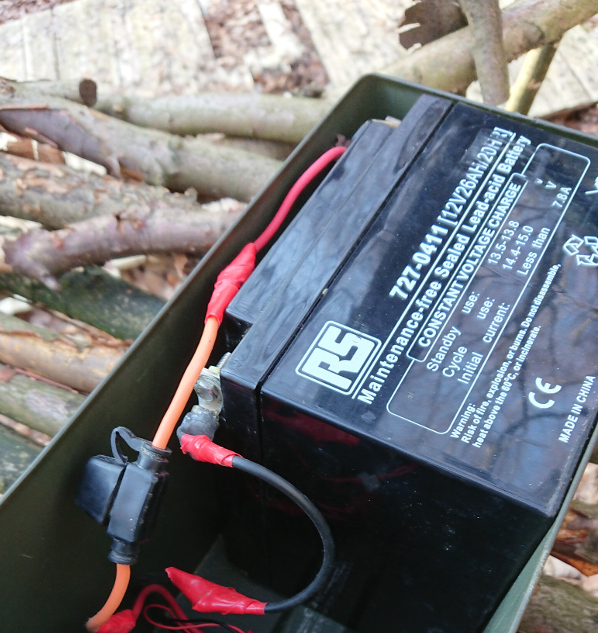Using an ammo box as portable 12V power supply

I don't suppose I'm the first person to think of this, but I wanted to share my experience of using an ex-military NATO ammunition box as a housing for a portable, high capacity 12V power supply. A power supply like this is useful for camping and other outdoor activities.
My design uses a sealed lead-acid (SLA) golf-cart battery. A battery like this will power computer and radio equipment, lights, and many other things, out in the field. It will charge small devices like mobile phones many times. It will boil water in a camping kettle, if you aren't in a hurry. Although there are more modern battery technologies, SLA batteries are easy to charge, can supply huge currents, and can (indeed, must) be stored charged.
With a bit of metalwork (well, a lot of metalwork) you can install a voltmeter, to get an idea of the battery condition. If you're in a location with no mains supply to recharge the battery, you can use an inexpensive solar panel top-up charger.
I buy these ammo boxes in quantity, because they are useful for many things -- some electronics-related, some not. They can be used for tool storage, for example, or just for workshop security -- they can be padlocked shut and chained to an anti-theft bolt. And, of course, you can store ammunition in them, should the need arise.
Ammo boxes have a number of advantages as battery carriers, in addition to their low cost: they are extremely robust; they have a built-in carrying handle; they can be drilled (with some difficulty) to fit controls and sockets; and they stack well. Although not weather-sealed, when the lid is closed rainwater will not enter the box if it is stored upright.
At present I'm using a 26 amp-hour battery, RS Components part number 727-0411. A battery like this will cost (ouch) £50-60. I have in the past been able to squeeze a 40 A.h battery into the box, but it was a tight fit, and I haven't been able to source another one of that capacity that will fit.
An SLA battery can be charged using an ordinary car battery charger, but be careful of the specification for charging current -- if your battery charger has a "fast" mode, it may well overheat the battery. I modified my car battery charger to add a plug that will connect directly the battery box's output socket -- trying to attach crocodile clips to the battery terminals is likely to lead to shorts.
If you're going to build one of these battery boxes yourself, here are a few things to think about.
- Most obviously, you'll need to check the battery supplier's published dimensions very carefully, to ensure you'll get a good fit in the box. You want to make the best use of the space, but you don't want the battery terminals to short on the metalwork, which is a risk if the battery is crammed into the box.
- Bear in mind that there's unlikely to be any safe way to fasten wires to the battery terminals when the battery is in place. Your spanner or screwdriver will short to the case. Instead, you need to leave just enough slack in the wiring to attach the terminals with the battery just out of the box.
- You should pack the battery out so that it can't move when the box is carried. No only does the movement of a heavy battery create a risk of damage, it also increases the likelihood that the terminals will come into contact with something they shouldn't. I used self-adhesive rubber door insulation strip: a single layer fastened to the top and bottom of the battery makes it a tight, padded fit. You could perhaps use multiple layers if the battery is larger. Lining the whole box with sound-insulating rubber foam might also be worth trying.
- You'll need to give some thought to the power socket you'll fit. A battery like the one I use can supply 100 amps, for short periods, but it's unlikely that any practicable power connector will handle such a current, even if you have an application that needs it. A car cigarette lighter socket is an obvious choice for 12V, but they are typically only rated for 10A, and they don't make a very secure connection. There are specialist, military connectors, but they are ruinously expensive. I'm using a Hella-style 24V truck connector -- these are inexpensive, make a secure fit, and are rated for 16A. It's easy to buy, or make, an adapter connecting a Hella socket to appliances fitted with cigarette-lighter plugs.
- Whatever connector you fit will govern the thickness of wiring you need, and the Fuse you'll fit. The fuse is not optional in this application. Shorting the power terminals of a high-current battery will cause the kind of damage to which the term 'blast radius' is appropriate. The fuse should be rated as low as whatever part of the current path has the lowest capacity -- the wiring or the connector. My cabling is rated 30A (at 70 degrees Celsius) but the connector only 16A, so I fitted a 15A inline fuse.
- I built my battery box before cheap digital automotive voltmeters were available. There's no particular functional advantage to a digital meter in this application, but it might require a smaller panel cut-out.
- It's now possible to buy an automatic circuit breaker for 12V applications, that incorporates a switch. These are usually rated for 50A or higher so, although the circuit breaker would be more convenient than a fuse, they would not be appropriate unless you were using wiring and a connector rated for this kind of current.
- In general, it won't hurt if a little rainwater gets into a 12V battery box. Rainwater is not a sufficiently good conductor of electricity to cause electrical problems. However, it will eventually cause corrosion. Ammo boxes are reasonably water-resistant when closed, and I used a panel-mounting voltmeter with a water-resistant rubber gasket. The Hella socket also has a rubber bung to keep water out, although it's not completely watertight. The small pushbutton that switches on the voltmeter's backlight is not waterproof at all, and has become very stiff to operate.

The battery box works very well in practice, but there are a few things to be careful about.
First, most SLA batteries will not stand being run completely flat. If they ever discharge below about 9V, their charge capacity will probably be damaged, as will their lifespan. If you run the battery so low that it doesn't even register on a voltmeter, it's probably time to buy a new one. Ideally, batteries of this type need to be stored fully charged; they will discharge by themselves over a period of a year or so.
Second, I'm unsure whether it is safe to charge the battery with the case closed. These batteries are, by definition, sealed, but I'm not sure they are gas-tight. I haven't been able to get consistent information from battery vendors so, to be safe, I always open the lid when I charge the battery. Fortunately, this is easy to do with an ammo box.
Third, it's not exactly suitably for backpacking applications: the total weight of the battery box with a 26 amp-hour battery is more than 10kg.
I've been using this battery box for nearly fifteen years, and it's served me well all this time. It's taken a lot of hard use, and survived a good deal of harsh weather. Each battery has lasted about five years so, although they are expensive, they're good value in the long term.
